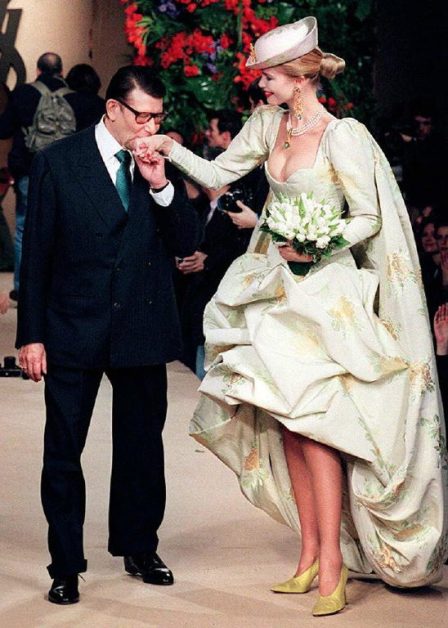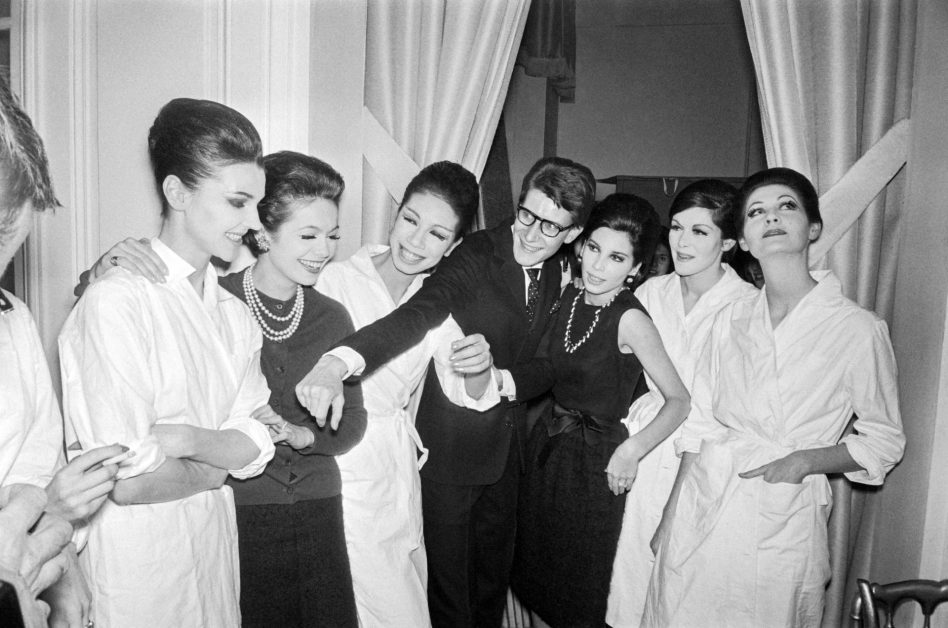From the day he founded his fashion house on December 4, 1961, until his passing in 2008 due to brain cancer, Yves Saint Laurent has been an integral part of French cultural heritage. On August 1st, we commemorate the birthday of the late designer, Yves Saint Laurent, who revolutionized the world of fashion and created the iconic women's tuxedo, transforming this traditionally masculine piece to suit the lifestyle of working women, achieving a feminine look for the suit.

However, what many don't know is that he also created designs made of “Silk Lyon.” At the age of seventeen, the late designer would craft dolls and cut them out from fashion magazines bought by his mother, designing clothes for them. He would then write the names of Lyon fashion houses on each piece of clothing, indicating the fabric he used for the doll's outfit. He got to know these fashion houses through advertisements displaying the designer's name and the manufacturer's name.
The fabric was the basis of his movement. Some designers start with drawings, while others start with the fabric. Yves Saint Laurent, on the other hand, would directly draw on the fabric itself. By looking at these preliminary sketches representing swaying models, supervisors and craftsmen in the workshops could immediately tell if it was muslin, satin, or taffeta, as the fabric determined the movement of his designs, revealing his genius in the world of fashion.
Sometimes, the designer's ideas stimulated innovations, as seen with one of his favorite fabrics, the synthetic “Sigaline” fabric, developed by the “Bucol” house. It was thin, lightweight, and durable at the same time. If the designers wanted to use a heavy fabric coated in gold, they had to invent a way, and Lyon, which relied on advanced technology, quickly responded to the designer's desires. They created a type of plastic coated with gold, a flexible material that attracted light and did not rust. Thus, Yves Saint Laurent executed what is known as the “Shakespeare” wedding dress, which was showcased in 1980 and featured precious fabrics, including a patterned fabric, a Damascus brocade, and five layers of tulle made of Lyon.

Yves Saint Laurent's fashion house used a lot of rolls of fabric and only paid for the ones they used. This meant that silk weavers did not earn much money, but they gained significant fame. These silk workshops saw record-high sales.
After the end of the era of fashion geniuses and the departure of senior fashion designers like Yves Saint Laurent, Hubert de Givenchy, and Karl Lagerfeld, today's “creative directors” still use exceptional materials, but their relationship with fabric is not the same.
In 2018, the auction house “Cornette de Saint Cyr” announced drawings that had never been revealed before of Yves Saint Laurent, which he created in the early 1960s for the late Parisian publisher Jack Damas. The drawings were intended for a children's book that was never published.

Damas asked Yves Saint Laurent to draw these illustrations after meeting him through his friend, the famous shoe designer Roger Vivier, according to the auction house, which estimated the drawings to be valued between 300 and 1500 euros.
Yves Saint Laurent gained fame from his first fashion show at the house of Dior, where he replaced the founder of the house in 1957. During that period, his “Trapeze” (flared) lines were an unprecedented success.
On December 4, 1961, he founded his own house in partnership with Pierre Bergé and set up his headquarters on Spoutini Street in Paris. This logo, with its intertwined black initials, symbolized French elegance.

Yves Saint Laurent was 25 years old when he presented his first fashion collection on January 29, 1962. He invented the wardrobe for the modern woman, which included the short coat, trench coat, and jumpsuit. His brilliance lay in adopting masculine symbols and granting women their freedom, becoming a revolutionary symbol for all women, not just his wealthy clients.
Yves Saint Laurent designed for all arts, including theater, dance, and cinema. He was friends with artists and created tribute collections for prominent artists such as Matisse, Cocteau, Van Gogh, Picasso, and others. Among his most iconic designs were his “Mondrian” dresses, which he created in tribute to the Dutch painter, as well as pop art-inspired designs and others inspired by African heritage.
The haute couture house of Yves Saint Laurent closed its doors in 2002 when Yves Saint Laurent decided to retire. In 1974, the house moved to a private hotel on Marsot Avenue, which now houses the Yves Saint Laurent Foundation. Today, the foundation hosts exhibitions by artists close to the designer. The fashion world still holds tribute exhibitions for Yves Saint Laurent's works wherever they are, as his legacy lives on even more than 15 years after his death, and the house today diligently reclaims his iconic designs in every collection they release.
